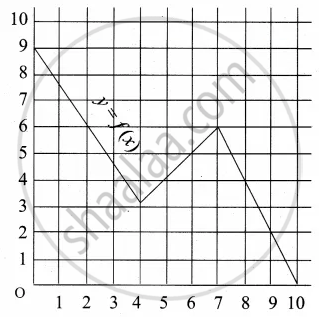Advertisements
Advertisements
प्रश्न
Let f and g be two real functions defined by \[f\left( x \right) = \sqrt{x + 1}\] and \[g\left( x \right) = \sqrt{9 - x^2}\] . Then, describe function:
(vi) \[2f - \sqrt{5} g\]
उत्तर
Given:
\[f\left( x \right) = \sqrt{x + 1}\text{ and } g\left( x \right) = \sqrt{9 - x^2}\]
Clearly,
Thus, domain (f) = [1, ∞]
Again,
⇒ \[x \in \left[ - 3, 3 \right]\]
APPEARS IN
संबंधित प्रश्न
Which of the following relations are functions? Give reasons. If it is a function, determine its domain and range.
- {(2, 1), (5, 1), (8, 1), (11, 1), (14, 1), (17, 1)}
- {(2, 1), (4, 2), (6, 3), (8, 4), (10, 5), (12, 6), (14, 7)}
- {(1, 3), (1, 5), (2, 5)}
Let X = {1, 2, 3, 4} and Y = {1, 5, 9, 11, 15, 16}
Determine which of the set are functions from X to Y.
(a) f1 = {(1, 1), (2, 11), (3, 1), (4, 15)}
If \[y = f\left( x \right) = \frac{ax - b}{bx - a}\] , show that x = f(y).
If \[f\left( x \right) = \begin{cases}x^2 , & \text{ when } x < 0 \\ x, & \text{ when } 0 \leq x < 1 \\ \frac{1}{x}, & \text{ when } x \geq 1\end{cases}\]
find: (a) f(1/2), (b) f(−2), (c) f(1), (d)
If f(x) = loge (1 − x) and g(x) = [x], then determine function:
(i) f + g
Write the range of the function f(x) = sin [x], where \[\frac{- \pi}{4} \leq x \leq \frac{\pi}{4}\] .
Let \[f\left( x \right) = \frac{\alpha x}{x + 1}, x \neq - 1\] . Then write the value of α satisfying f(f(x)) = x for all x ≠ −1.
If f : R → R be given by for all \[f\left( x \right) = \frac{4^x}{4^x + 2}\] x ∈ R, then
The domain of definition of \[f\left( x \right) = \sqrt{4x - x^2}\] is
If f(m) = m2 − 3m + 1, find f(0)
If f(m) = m2 − 3m + 1, find f(− x)
If f(x) = `{(x^2 + 3"," x ≤ 2),(5x + 7"," x > 2):},` then find f(3)
Which of the following relations are functions? If it is a function determine its domain and range:
{(2, 1), (4, 2), (6, 3), (8, 4), (10, 5), (12, 6), (14, 7)}
If f(x) = 3x + a and f(1) = 7 find a and f(4).
Which sets of ordered pairs represent functions from A = {1, 2, 3, 4} to B = {−1, 0, 1, 2, 3}? Justify.
{(1, 0), (3, 3), (2, −1), (4, 1), (2, 2)}
Which sets of ordered pairs represent functions from A = {1, 2, 3, 4} to B = {−1, 0, 1, 2, 3}? Justify.
{(1, 1), (2, 1), (3, 1), (4, 1)}
Find x, if g(x) = 0 where g(x) = 6x2 + x − 2
Check the injectivity and surjectivity of the following function.
f : Z → Z given by f(x) = x2
Check the injectivity and surjectivity of the following function.
f : N → N given by f(x) = x3
Show that if f : A → B and g : B → C are one-one, then g ° f is also one-one
lf f(x) = 3(4x+1), find f(– 3)
Express the following exponential equation in logarithmic form
231 = 23
Express the following exponential equation in logarithmic form
3–4 = `1/81`
Express the following logarithmic equation in exponential form
log2 64 = 6
Express the following logarithmic equation in exponential form
`log_5 1/25` = – 2
Write the following expression as a single logarithm.
ln (x + 2) + ln (x − 2) − 3 ln (x + 5)
Solve for x.
log2 + log(x + 3) – log(3x – 5) = log3
Solve for x.
x + log10 (1 + 2x) = x log10 5 + log10 6
If f(x) = 3x + 5, g(x) = 6x − 1, then find (f − g) (2)
Answer the following:
A function f is defined as : f(x) = 5 – x for 0 ≤ x ≤ 4. Find the value of x such that f(x) = 5
Answer the following:
Let f : R → R be given by f(x) = x + 5 for all x ∈ R. Draw its graph
Answer the following:
If a2 = b3 = c4 = d5, show that loga bcd = `47/30`
A graph representing the function f(x) is given in it is clear that f(9) = 2

Describe the following Domain
A function f is defined by f(x) = 2x – 3 find x such that f(x) = 0
A function f is defined by f(x) = 2x – 3 find x such that f(x) = x
The domain of the function f(x) = log3+x (x2 - 1) is ______.
The range of the function f(x) = x2 + 2x+ 2 is ______.
The period of the function
f(x) = `(sin 8x cos x - sin 6x cos 3x)/(cos 2x cos x - sin 3x sin 4x)` is ______.
